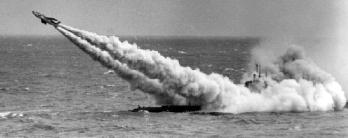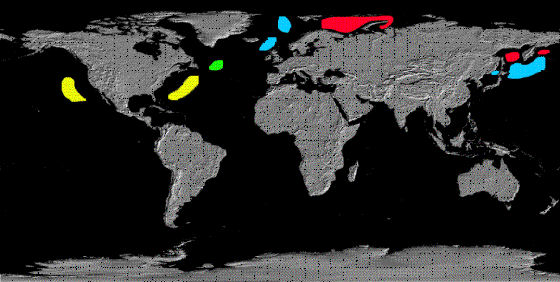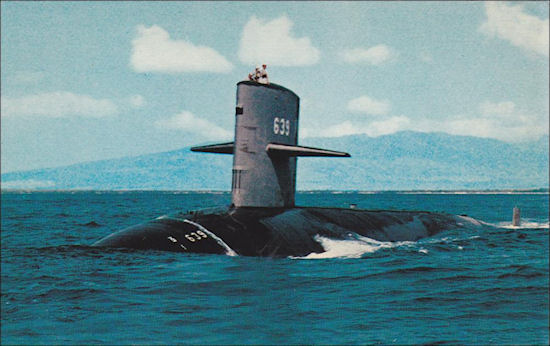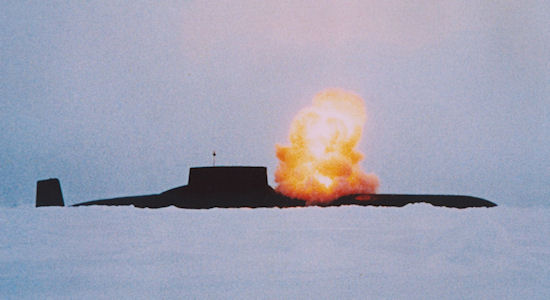Submarines were used for the first time in large numbers and played a significant strategic role, during World War I. At that time the first concepts on submarines’ operational tactics and missions began formulating.
The German Imperial Navy developed submarines as an antidote to Britain's undisputed dominance at sea and originally intended to use them alongside its own high seas fleet. At the same time, it would be another valuable tool in enforcing a naval blockade. As it turned out submarines were not able to follow surface fleet units due to their inferior speed and quickly became independent attack units, mainly against merchant ships.
Things did not change significantly during World War II. The Germans tried to use submarines to disrupt England’s supply routes from the USA. There were few cases of attacks against surface warships, and most of them were either accidental encounters or daring special missions (such as the famous U-47 raid on the British fleet at Scapa Flow on October 13, 1939).
In the Pacific Ocean, US Navy submarines also focused on attacking Japanese logistics, although the morphology of the theater of operations (many islands, narrow straits) allowed them in several occasions to engage surface warships.
During WWII submarines were also used for special operations, landing commando units and spies on enemy occupied beaches, but also the collection of information through the monitoring of sea traffic.
New roles and missions
The use of the snorkel was a development which triggered a series of important changes in the submarines’ tactical environment. A submarine sailing submerged, using the snorkel near the surface, had a very small radar cross-section, making it extremely difficult to be detected at medium and long distances. But the noise emanating from the diesel engine was completely diffused into the water. It was therefore obvious that passive sound detection would be the new main method of locating submarines at medium and long distances. On the other hand, a submarine using its electric motor at low speed created the best possible conditions for the operation of the passive sonar and thus the detection of other submarines.
In essence, the submarine emerged as the best platform for anti-submarine warfare and SSKs were born, the attack submarines, with the main mission of locating and destroying other submarines.
In 1947 the US Navy successfully experimented with launching a German V-1 missile from the SS-348 Cusk. Thus began the evolution of the Regulus, a cruise missile with a range of 400nm, capable of carrying a nuclear warhead. There was a similar development on the part of the Soviet Navy. In the early 1950s, US intelligence estimated that the only way the Soviet Union could strike the continental United States with nuclear weapons was with a submarine-launched missile.
 |
Both countries converted significant numbers of submarines to SSGs and later to SSBs configurations, giving them greater offensive range, heavier firepower and new operational concepts. It should be noted that at a time (1950s) when intercontinental ballistic missiles and strategic bombers had not yet been developed, or had significant range limitations, and increased vulnerability, a submarine which would be able to approach enemy shores undetected, was the only reliable platform for launching a nuclear attack.
But the evolution that dramatically changed submarine warfare was the dawn of the nuclear age. The use of nuclear energy for the propulsion of submarines dramatically improved their capabilities, providing them with speed and autonomy equal, if not superior, to surface warships.
Submarine types according to their operational role
The evolution of passive sonar in the early 50's and the placement of passive sonar devices in submarines created SSKs, attack whose main mission was locating and destroying enemy submarines. Nuclear-powered attack submarines are referred to as SSNs.
The ability to launch cruise missiles from submarines, created the SSG. They were originally designed by the US Navy to launch nuclear-tipped missiles. But the Regulus missile program was abandoned in 1957 to save money for the development of the Polaris. So the US Navy abandoned this type of submarine. On the other hand, the Soviet Navy, despite developing its own ballistic missile program, retained the SSGs, altering their primary mission. The Soviet SSG and SSGN (nuclear powered) had as their main mission the destruction of American aircraft carriers which were the main weapon of the US Navy.
The evolution of ballistic missiles, launched from submarines (SLBM) led to the creation of SSBs and SSBNs.
After 1955, the United States turned exclusively to the construction of nuclear submarines. The only exception was the AGSS-589 Dolphin, which entered service in 1968 as a development and testing platform, and has the ability to descend to great depths. Of course, the conventional submarines that were built before 1955 were kept in service. The last of them was decommissioned in 1990.
On the contrary, the Soviet Navy did not stop building diesel submarines. The main reasons for this differentiation are related to:
- the need to tackle a numerically and qualitatively superior naval force
- the prospect of waging a war of attrition in the Atlantic in the event of a conflict in Europe
- the need to protect a very long coastline
Deterrence patrols
Throughout the Cold War, SSBNs were the main platform for launching a first strike. Ballistic missiles submarines had, and still retain, significant advantages over all other strategic nuclear weapons platforms.
In contrast with intercontinental missiles silos they can be continuously mobile and therefore cannot be pre-targeted. They also have an advantage in launch warning, as the silos are located in the interior of each country, while a submarine can launch even within a few nautical miles from the enemy shore.
They also have an advantage over mobile intercontinental ballistic missiles launchers. The mobile launchers have the ability to move but this is quite limited geographically, and any case they will still remain very far from the target, thus providing the enemy with advanced warning.
Strategic bombers are the most vulnerable platforms and the most easily detected, due to their operational environment.
An SSBN can appear out of nowhere in a matter of minutes, launch and disappear again.
In order to take full advantage of their operational characteristics, both the USA and the USSR, maintained a portion of their respective SSBN fleets at sea. The SSBNs patrolled specific areas, according to their predetermined targets, at very low speed evading detection and ready to launch their missiles within minutes of receiving the order.
These patrols became known as deterrence patrols. The U.S. Navy had about 50% of the operational SSBNs at sea at all times, until at least the early 1990s. Their patrols lasted 80-100 days, and in order to increase the time that an SSBN could remain on patrol, each vessel had 2 crews (gold and blue) which alternated in service after the end of each patrol. The precise patrol areas of the US Navy SSBNs remain one of the best guarded secrets of the USA.
On the other hand, the Soviet Navy usually had only 10-15% of the SSBNs on patrol. Their patrols usually did not last more than 60 days. In the mid-1990s, US intelligence released maps showing Soviet SSBN patrol areas. It has not been clarified whether these are actual data or estimates.
 Soviet Navy deterrence patrol areas Yellow: Yankee SSBNs, until the late 1970s Green: Delta I SSBN, mid 1970s - end 1980s Blue: Delta II, III, mid 1980s Red: Delta IV, Typhoon, mid 1980s, 1990s |
Soviet SSBN patrol areas gradually moved from the US coast to the Arctic Ocean, just outside their own bases. This change is apparently due to the gradual increase in the range of their ballistic missiles.
The response of each superpower to the other's deterrent patrols was to try to locate and monitor enemy SSBNs so that at the first sign of a possible launch they could be attacked and destroyed. Thus began a dangerous game between SSNs and SSBNs
War games
Most Cold War-turning-hot scenarios were starting with an escalating conflict between NATO and Warsaw Pact forces in Europe. There were two major sea-warfare issues that both sides would have to deal with:
a) The positioning of SSBNs that had to be in full readiness in predetermined areas in order to launch their missiles. There were the SSBNs that would be on deterrence patrols, thus already where they were supposed to be, and those still at their bases and would have to sail immediately. The US Navy had a significant advantage as it maintained a larger percentage of its SSBNs in deterrence patrols. Furthermore the Soviet SSBNs were much nosier and, at least until the mid 1980s, had to pass through choke points covered from the SOSUS early warning hydrophone network.
b) The importance of the Atlantic sea routes, since a war in Europe would have similar characteristics to World War II. Despite advances in aviation, the amount of supplies required by the NATO forces fighting in Europe could only be delivered by sea. The USSR, not having a the fleet that could challenge the NATO naval forces, relied on submarines to intercept this flow of supplies, while the NATO Navies had to keep the Atlantic sea lanes open and safe.
In the 1960s the US Navy adopted the barrier tactic, using the SOSUS early warning hydrophone network and SSNs in advanced patrol positions to form the GIUK Line (Greenland, Island, U.K.) as the main line of defense in the Atlantic Ocean.
In 1962 the SOSUS arrays were still mainly deployed in areas of the western Atlantic and the barrier tactic mainly a concept and not an operational reality. During the Cuban Missile Crisis, 5 Soviet submarines managed to sail from the Kola Peninsula to Cuba undetected, until they reached the ships that enforced the naval blockade of the island, causing great unrest in the US Navy.
By the late 1970s, Soviet SSBNs were able to launch their missiles without having to approach the GIUK line. The reaction from the US Navy was to move the patrol positions of the advanced SSNs further north.
A war in Europe was expected to last from 30 to 60 days before nuclear options would be seriously contemplated. During that time NATO SSNs would have to locate and destroy the Soviet SSBNs.
In the mid-1970s a significant change in the Soviet Navy tactics was observed. Greater emphasis was placed on the use of friendly SSNs to protect their SSBNs, both as escorts and also through the proactive detection of enemy SSNs. Until then, the main role of the Soviet SSNs was independent action with the objective of interrupting maritime communications in the event of a conflict.
This reason for this change in tactics troubled the US Navy, until in 1981 the detection of the Walter spy ring revealed that the Soviets had been received detailed information on the vulnerability of their SSBNs. This information, along with an insight on the US Navy submarine doctrine and tactics, contributed in the Soviet submarine design shifting towards noise reduction.
By the mid 1980s the new classes of Soviet submarines, and the older retrofitted ones, were much quieter and the SSBNs patrol areas were much closer to their bases, providing them with maritime aircraft and surface units cover.
During the 1990s, and to these days, US Navy Ohio SSBNs continue to conduct deterrent patrols. On the other hand, the Russian Navy has largely abandoned them. On several occasions, however, Oscar-class Russian SSGNs have been spotted off the coast of the United States, or shadowing aircraft carrier groups. During the NATO attacks in Kosovo, several Russian submarines appeared near NATO surface groups, sending an obvious a political message. On the other hand, US and Royal Navy SSNs continue to closely monitor the bases of Russian submarines, and the dangerous war games still go on.
Living dangerously
The main concept of the "game" is for one submarine to locate and trail another without being detected. This was a situation that until the early 1980s was almost an exclusive advantage of US Navy submarines. This was due both to the poor noise performance of Soviet submarines and to the more sophisticated US Navy passive detection equipment and software that allowed advanced processing and analysis of audio signals.
A typical case is that of the SSN-661 Lapon (Sturgeon class) which in 1969 in the North Atlantic, using the advanced passive detection capabilities that were first used in the submarines of her class, managed to trail a Soviet submarine for 40 days, undetected. Lapon's sonar operators became so familiar with the sounds and daily functions of the Soviet submarine that they went so far as to give nicknames to individual members of the crew.
The image of 2 submarines with a displacement of a few thousand tons, and lengths close to or above 100m, sailing practically blind under the sea, at a distance quite often less than 5,000m, relying only on passive sonar and with the leading submarine unaware of her tail, is one of the most unnatural situations imaginable. In many cases even pictures were shot, with the trailing submarine approaching the stern of her target from below, sometimes as close as 200m.
It was not uncommon for such close encounters to have tragic results. In June 1970 SSN-639 Tautog was monitoring K-108, an Echo II SSGN in the North Pacific. At one point the captain of the Soviet submarine made a sudden 180o turn in an attempt to check her wake and determine if she was being trailed. The two submarines barely escaped a head to head collision and the Soviet submarine propellers hit Tautog’s sail. For many years it was believed that the K-108 had sunk, but as it was revealed in the 1990s she managed to return to her base.
 |
Even after the end of the Cold War, these missions, maybe the most dangerous in peacetime, continue to generate extremely dangerous situations. The reasons that they were considered necessary in the first place, and continue to be considered so, are many.
The primary reason is that locating and trailing an SSBN is the only way to prevent an imminent launch. At several times during the Cold War, US Navy SSN captains were authorized to attack the Soviet SSBN they were trailing, if a launch was detected.
Another important reason is that while trailing an enemy submarine, valuable data concerning the technical characteristics and capabilities of the enemy submarine can be gathered.
Also, these missions are the best training environment for submarine crews, as they represent actual engagement situations and conditions.
Despite the changing international scene and the easing of tensions between the USA and Russia, there is still mutual distrust which can very often lead to dangerous situations. On December 3, 1997, a Typhoon class (P941) SSBN performed a pre-arranged launch of SS-N-20 ballistic missiles (nuclear warheads removed), which were to be destroyed at an altitude of 2Km. The operation took place under the START I treaty to reduce strategic nuclear weapons and was monitored by a USA verification committee on an nearby oceanographic vessel. Soviet anti-submarine forces in the area detected the presence of a Los Angeles class SSN, less than 2 miles from the Typhoon. Despite repeated communication efforts, the US Navy submarine did not respond, nor did she move away, until training depth charges were launched against her.
 |
The number of submarine attacks on surface ships recorded since World War II is only 2. The first was in 1971 when the Pakistani SSK Hangor sank the Indian frigate Kurki. The second and most famous, on May 2, 1982, during the Falklands War, when the British SSN Conqueror sank the cruiser General Belgrano along with more than 400 crew members. This mission was of particular importance as it effectively forced the entire Argentine navy to return to its ports.
In the 1990s another type of mission for submarines emerged. In 1991, during the Gulf War, the SSN-724 Louisville from the Red Sea and the SSN-720 Pittsburgh from the Mediterranean, fired 12 missiles at targets in Iraq. The Los Angeles-class SSNs carry 12 BGM-109 Tomahawk cruise missiles. It was the first time that submarines were used against remote ground targets.
Intelligence gathering
Another important mission of submarines is to gather intelligence. There are many cases where submarines of one side or the other were found in the middle of the opponent's naval exercises with the main goal of monitoring and gaining insights on the operational tactics and the capabilities of the weapons systems.
As was the practice during the 2 World Wars, quite often submarines monitored important naval bases of the enemy, in order to gather information about the movements of the enemy ships.
In August 1957, the diesel-powered USS Gudgeon was patrolling near the largest Soviet naval base in the Pacific, in Vladivostok. Through her periscope she observed the movements of Soviet ships and gathered information by monitoring electronic communications. At one point her presence was noticed by the Soviets and about 8 anti-submarine warships went after the submarine. Gudgeon dived under 200m and tried to hide. Soviet ships using active sonar spotted the Gudgeon and began dropping small training-type depth charges, trying not to sink, but to force her to surface. Gudgeon could not communicate with friendly forces, as she could not reach communication depth. Every time she tried to move to escape from the Soviet ships they managed to locate her. Her batteries began to drain, and after 30 hours of hide and seek there was no electricity and the air inside became unbearable. The captain decided to risk surfacing and possible boarding. After surfacing and exchanging visual messages with the Soviet ships, she was allowed to leave. This was considered a major psychological defeat for the US Navy, and shortly afterwards, Admiral Wright, Commander of the Atlantic Fleet, issued an unofficial order announcing that the first US Navy submarine or ship, or naval aircraft that would manage to "shame" a Soviet submarine would win a box of "Jack Daniels Old No7 Brand of Quality Tennessee Sour Mash Corn Whiskey". The USS Grenadier won the "prize" in May 1959 when she managed to locate and trail a Soviet submarine off the coast of Iceland, forcing her to surface.
In 1963, SSN-579 Swordfish was detected while closely shadowing a Soviet naval exercise. Although she was chased for 2 days, she managed to escape because, unlike the Gudgeon, she was nuclear-powered. There was no need to surface for air and she could sail at speeds similar to the ships that chased him. During this operation Swordfish gathered valuable information about the Soviet Navy's anti-submarine tactics, the frequencies and repetition rates of Soviet surface radars.
Several of the intelligence gathering missions were similar to movie scripts. SSN-683 Parche, as well as the specially modified SSN-575 Seawolf and SSN-587 Halibut were used in special missions. Perhaps the most notable of these, codenamed Ivy Bells, involved the tapping of a Soviet underwater communications cable in the Sea of Okhotsk, which separates the Kamchatka Peninsula from mainland Siberia. After the initial installation of the interception and recording device, there were frequent servicing missions for collecting the recorded data. This operation lasted from the mid 1970s to 1981, when it was revealed to the Soviets by a spy.
The Soviets attempted to launch their own similar operation in 1985. American satellites located a Soviet submarine in shallow Atlantic waters. Immediately US Navy SSN was sent and discovered that a group of divers was trying to locate a submerged cable to install an eavesdropping device. The operation reportedly failed due to an accident that killed at least 2 divers.
Maybe the most notorious special operation took place in the early 1970s. During the last days of March 1968 the Soviet Navy deployed several units in the Pacific in what looked like a search for a missing submarine. US Navy conducted a review of the SOSUS Pacific Ocean arrays recordings and managed to isolate two abnormal events on March 8, and March 11, 1968, that could be interpreted as explosions and related to a possible submarine track. The triangulation of the recordings from different arrays provided a possible location (aprox. 1600miles NW of Hawaii and 1.200 SE of the Kamchatka Peninsula) that was nowhere near the area that the Soviets were searching.
Later that year SSN-587 Halibut was sent to investigate the area, and was able to locate the wreck at a depth of about 5,000m. The submarine that had sunk was the K-129, a diesel-powered Golf-class ballistic missile submarine. Immediately after the wreck was located, the idea of a recovery operation was born. The prospect of closely examining a Soviet sea-launched ballistic missile along with code books and other equipment, was far too intriguing.
Although it has never been acknowledged, there has been speculation about a possible collision with SSN-579 Swordfish. The latter arrived in Yokosuka, Japan on March 17, 1968 with obvious damage on her sail.
Under the pretext of deep-ocean mining operations, and using Howard Hughes and his company Global Marine as a front, the CIA funded the construction of the Glomar Explorer. The huge ship, almost 200m long and with a displacement of 50,500tn, entered service in 1973 and was immediately taken to the site of the wreck. Hughes, who allegedly worked with the CIA on other occasions, provided the necessary cover story.
 |
The operation, codenamed Project Azorian, managed to recover part of the K-129 in 1974. The salvaged part contained 2 torpedoes with nuclear warheads, crypto gear and the remains of 8 sailors that were buried at sea by the Glomar Explorer. In the spring of 1975, after the story was reported by the Los Angeles Times and the New York Times, US Secretary of State Kissinger briefed Soviet Ambassador Dobrynin on the operation.
Submarines and especially nuclear-powered submarines were the primary weapons of the Cold War, both psychologically and operationally. Freedom of Information Act requests and the declassification of some archives are shedding light on many aspects of naval history during the Cold War. But even today crew members that participated in the most delicate missions are still bound by secrecy for up to 80 years. And, there are many who are "still on patrol": these are the victims of this cruel, unknown and undeclared war.
See the next chapter of the series: Nuclear submarines accidents (coming soon)
See the entire series of articles on nuclear submarines
The silent war
Basic concepts in submarines' evolution
The true submarine
Nuclear submarines in the Cold War
Nuclear submarines accidents (coming soon)
Nuclear propulsion and the environment (coming soon)





